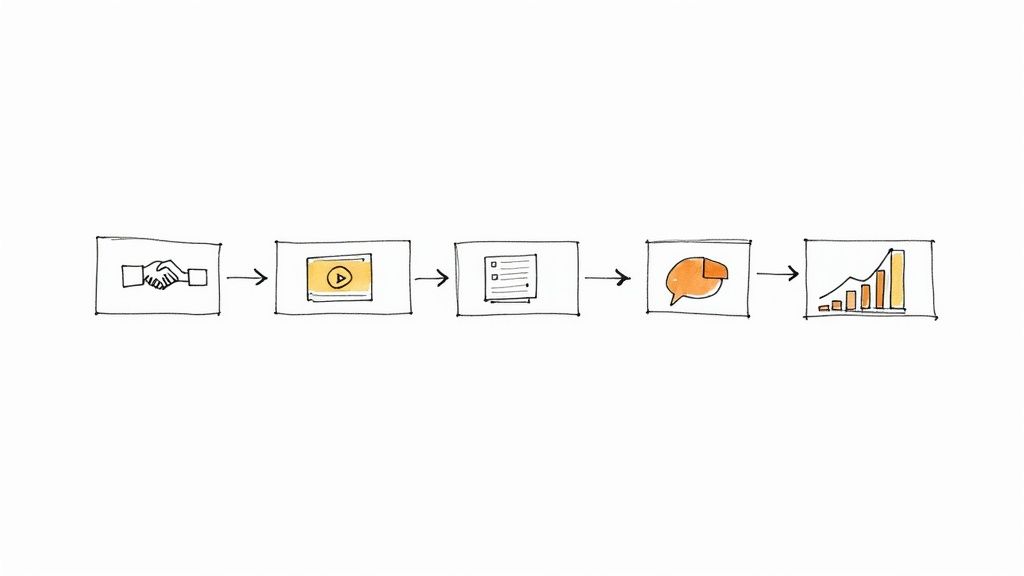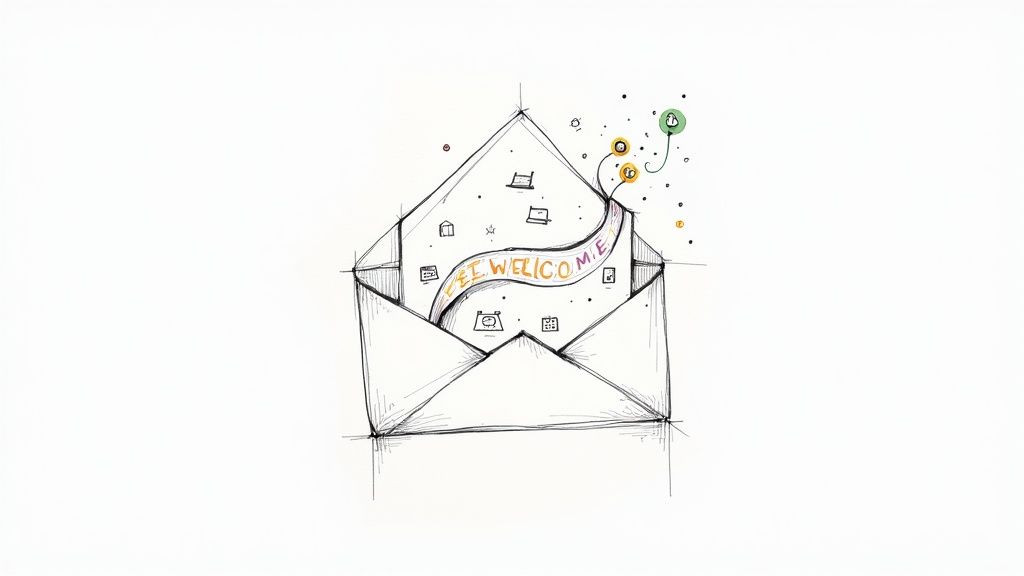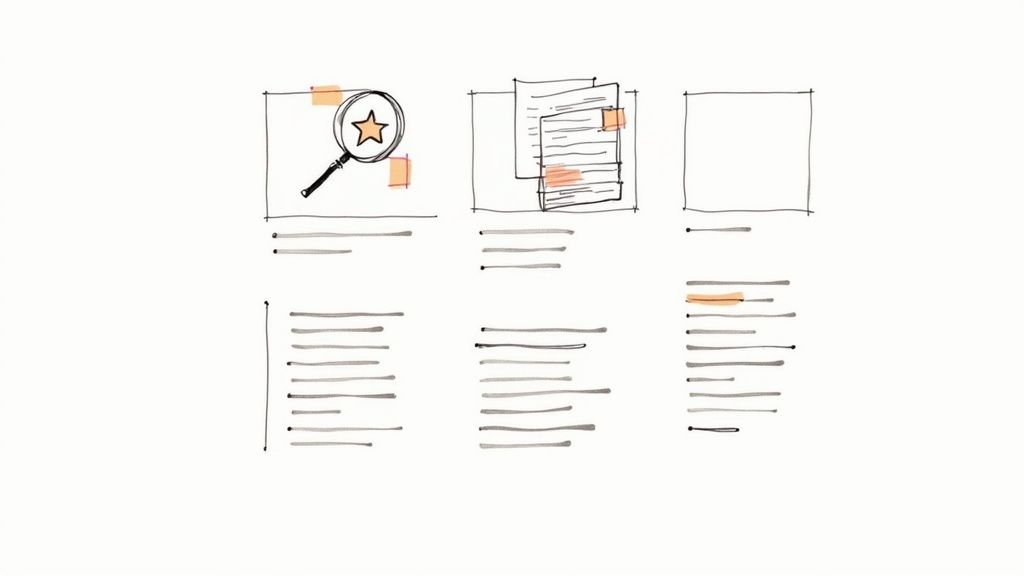
Guide to Client Onboarding Best Practices for Corporate Training
A successful client relationship begins with a world-class onboarding experience. Too often, this critical phase is treated as a simple checklist of administrative tasks and basic platform tutorials. However, for corporate training and development clients, onboarding is the first, most crucial step in ensuring long-term value, learner adoption, and partnership success. A weak start can lead to disengaged clients who never fully realize the potential of your training solution, resulting in poor retention and missed opportunities for growth.
This article dives into 10 client onboarding best practices that move beyond the basics, focusing on creating structured, engaging, and measurable learning journeys for your new customers. The principles of a well-defined process are universal, whether you're welcoming a new team member or a new client organization; many lessons can be borrowed from mastering the remote onboarding process for new hires. We'll explore actionable strategies to transform your onboarding from a procedural formality into a strategic advantage.
You will learn how to set clear expectations, deliver impactful training, and demonstrate value quickly. Furthermore, we'll illustrate how leveraging interactive video with platforms like Mindstamp can elevate each practice, turning passive clients into empowered, proficient training creators from day one and setting the stage for lasting success.
1. Personalized Welcome Process
First impressions are powerful, and a generic, one-size-fits-all welcome can make new clients feel like just another number. One of the most critical client onboarding best practices is to create a personalized welcome process. This approach tailors the initial experience to each client's specific industry, role, and stated training objectives, demonstrating from day one that you understand their unique needs.

This process moves beyond simply using a client's name in an email. It involves creating a customized roadmap that directly addresses their learning and development challenges. For example, a corporate training manager at a large tech firm has different needs than a small business owner. The former might receive a welcome kit focused on SCORM integration and learner analytics, while the latter gets a guide on creating their first interactive sales training video.
Actionable Steps for Implementation
To implement a personalized welcome, start gathering information before the official kickoff.
- Pre-Onboarding Surveys: Send a detailed questionnaire to collect information on their training goals, team structure, and technical requirements (e.g., existing LMS).
- Dedicated Success Manager: Assign a dedicated contact early. This person can use the survey insights to prepare a tailored success plan that aligns with the client's documented training objectives.
- Industry-Specific Playbooks: Develop onboarding materials specific to different verticals. A healthcare client will benefit from content addressing HIPAA compliance in training, while a retail client will need examples relevant to customer service training.
By tailoring the initial journey, you set a precedent for a proactive, value-driven partnership. This is where interactive video shines. You can create a welcome video that dynamically changes content based on the viewer’s role or industry, creating a truly unique learning experience. For a deeper dive into this technology, you can learn more about creating powerful personalized video experiences.
2. Clear Communication & Documentation
Uncertainty is a major cause of client churn during onboarding. Establishing clear communication channels and comprehensive documentation from the start is one of the most fundamental client onboarding best practices. This means providing clients with a central source of truth for timelines, expectations, support resources, and key processes, ensuring their training team never feels lost or confused about the next steps.

This practice is more than just sending a welcome email; it’s about building a structured information hub. For a corporate training client, this could mean a dedicated portal with video tutorials on creating their first interactive learning module, a guide to interpreting learner analytics, and a clear FAQ on troubleshooting common technical issues like LMS integration.
Actionable Steps for Implementation
To build a robust documentation and communication framework, focus on accessibility and clarity.
- Create a Centralized Knowledge Base: Use a tool like Notion or a dedicated help center to house all onboarding materials, from kickoff call recordings to technical setup guides and project timelines.
- Develop a Welcome Packet: Compile essential documents into a single, easy-to-digest packet. Include quick-start guides, key contacts, and a schedule for the first 30 days of training content creation.
- Establish Communication Protocols: Clearly define the best channels for different types of queries (e.g., email for strategic training questions, a dedicated Slack channel for quick technical help) and set expectations for response times.
By proactively addressing potential questions, you empower clients and reduce support dependency. Interactive video tutorials are particularly effective here, allowing you to embed clickable chapters and in-video questions to guide users through complex training setups, making the learning process both efficient and engaging.
3. Dedicated Onboarding Specialist Assignment
A disjointed onboarding experience, where clients are passed between different contacts, can quickly lead to frustration and confusion. One of the most effective client onboarding best practices is assigning a dedicated specialist to guide each new client. This individual acts as a consistent, reliable point of contact for the training team, ensuring a seamless transition and building a strong foundation of trust from the start. They become the client's advocate and expert guide, responsible for their initial training success.
This approach is more than just assigning a name; it’s about providing continuity and expertise. A specialist for a new L&D manager can provide targeted advice on integrating interactive video with an LMS, ensuring training materials meet compliance standards and drive learner engagement, rather than giving generic platform advice. They can share best practices specific to corporate learning goals.
Actionable Steps for Implementation
To implement this practice effectively, focus on structure and clear communication.
- Establish Clear Specialization: Train specialists to focus on specific industries or training use cases, like corporate compliance or sales enablement. This allows them to provide deeper, more relevant guidance.
- Introduce Specialist Early: Make the introduction during the final stages of the sales process. This creates a smooth handoff and lets the client know who their dedicated training partner will be.
- Document All Interactions: Use a CRM to log every conversation and training milestone. This ensures that if a handoff is ever necessary, the context and history of the relationship are preserved.
Having a dedicated specialist makes the client's training team feel valued and understood. This person can create a personalized interactive video welcome, introducing themselves and outlining the specific onboarding plan for developing their initial training modules. This personal touch sets a collaborative tone for the entire partnership.
4. Structured Implementation Milestones
Without a clear roadmap, the onboarding journey can quickly become overwhelming, leading to scope creep and client confusion. An essential component of client onboarding best practices is establishing structured implementation milestones. This approach breaks down the entire process into manageable phases, each with its own specific goals, training deliverables, and success criteria. It creates a predictable and transparent path that keeps both teams aligned and accountable.

Think of it like a corporate training rollout. Instead of a single, massive launch, you might have Phase 1 for technical setup and LMS integration, Phase 2 for creating a pilot training module, and Phase 3 for company-wide deployment. This methodology ensures momentum is maintained and progress is clearly visible. Each completed milestone serves as a checkpoint, confirming readiness before moving to the next stage.
Actionable Steps for Implementation
To build a structured implementation plan, you must define the journey from start to finish.
- Define Success Criteria: For each milestone, clearly document what "done" looks like. For a training module, this could be achieving a 90% completion rate or a certain score on an interactive quiz.
- Create a Visual Timeline: Use a Gantt chart or a shared project management tool to map out each phase, its dependencies, and its timeline. This visual aid helps manage expectations for the training program launch.
- Schedule Milestone Reviews: Hold dedicated meetings at the conclusion of each phase to review deliverables, gather feedback, and secure formal sign-off before proceeding. This prevents misunderstandings from compounding over time.
This structured approach is perfect for complex training projects. Interactive video can be used to kick off each milestone, clearly explaining the objectives and tasks for that phase. You can embed checklists or confirmation buttons directly in the video to track acknowledgment and readiness, ensuring everyone is prepared for the next step.
5. Comprehensive Training & Education Programs
True client success extends beyond simply knowing how to use your platform’s features. An essential component of client onboarding best practices is establishing a comprehensive training program that empowers your client's L&D team to become expert content creators. This approach shifts the focus from basic tutorials to strategic education, covering advanced techniques, industry-specific applications, and best practices that drive tangible learning outcomes.
A well-designed education program provides structured learning paths tailored to different user roles and experience levels. For a corporate training manager, this might mean a deep dive into creating interactive compliance modules, while a sales enablement specialist might focus on building engaging video-based sales collateral. This ensures every user gets relevant, valuable information.
Actionable Steps for Implementation
To build an effective training program, you need to structure content for accessibility and impact.
- Create Role-Based Learning Paths: Develop a training matrix that outlines specific courses and resources for different client roles (e.g., L&D admin, content creator, department manager). This ensures each user receives the most relevant information for their responsibilities.
- Offer Blended Learning Options: Provide a mix of synchronous (live webinars, virtual training rooms) and asynchronous (on-demand interactive videos, tutorials) formats to accommodate diverse learning preferences and schedules.
- Incentivize Completion with Certifications: Offer formal certifications upon completing specific learning paths. This not only motivates users but also creates internal champions and product experts within the client’s organization.
By investing in robust client education, you equip them with the skills to maximize your platform’s value independently. Interactive video is a powerful tool for this, allowing you to create self-paced training modules with embedded quizzes and branching scenarios. To explore this further, you can read more about educating customers with interactive video.
6. Quick Win Identification & Delivery
Nothing builds client confidence faster than immediate, tangible results. A critical component of client onboarding best practices is to strategically identify and deliver a "quick win" early in the relationship. This approach focuses on achieving a small, high-impact training goal within the first few weeks, demonstrating immediate value and proving your solution's effectiveness from the outset.
This tactic creates crucial momentum and justifies the client's investment. For a corporate training team using an interactive video platform, a quick win could be launching a single, engaging compliance module that achieves a 95% completion rate in the first week. This simple success sets a positive, results-oriented tone for more complex training initiatives down the line.
Actionable Steps for Implementation
To deliver quick wins, you must proactively look for opportunities during the discovery phase.
- Pinpoint High-Impact Needs: During kickoff, ask clients to identify their most pressing training challenge. Is it a low-engagement safety course or a confusing new software rollout? Target that first.
- Prioritize a Visible Launch: Choose an initial training project that will be seen by key stakeholders. A successful first deployment builds internal champions for your client.
- Measure and Broadcast Success: Define what success looks like beforehand (e.g., completion rates, quiz scores). Once achieved, create a simple report to share with the client and their leadership team to celebrate the training victory.
Delivering an early success makes clients feel smart for choosing you. An interactive video can serve as the quick win itself, such as creating a short, gamified product knowledge quiz for a sales team that immediately improves their scores. This initial positive result builds trust for the larger strategic partnership ahead.
7. Regular Check-ins & Progress Monitoring
Effective client onboarding is not a "set it and forget it" process. One of the most essential client onboarding best practices is to establish a consistent cadence of touchpoints to monitor progress, address roadblocks, and maintain momentum. These regular check-ins act as a crucial feedback loop, ensuring the client's training team remains aligned on goals and expectations.
This practice prevents minor issues from escalating into major problems. For a corporate training team implementing a new learning platform, weekly check-ins can help identify early adoption hurdles or technical snags. This proactive approach ensures the client achieves their desired training outcomes by identifying and resolving issues before they impact learners.
Actionable Steps for Implementation
To build a successful check-in structure, focus on consistency and preparation.
- Establish a Cadence: Schedule weekly or bi-weekly meetings at a consistent day and time to make them a predictable part of the client’s routine.
- Use a Standardized Agenda: Create and share an agenda template beforehand covering progress against training goals, open action items, new challenges, and next steps.
- Prepare Data-Driven Insights: Before each meeting, pull relevant data. For a training initiative, this could be learner completion rates or quiz scores from your interactive videos, providing concrete points for discussion.
- Document and Distribute: After each call, send a summary email detailing what was discussed, key decisions made, and assigned action items with clear owners and deadlines.
By implementing structured check-ins, you demonstrate a commitment to your client’s training success and maintain the project’s velocity. An interactive video can even serve as a pre-meeting briefing, allowing stakeholders to review progress on their own time and come to the meeting prepared for strategic discussions. You can discover how to use interactive video for effective project updates to make these sessions even more efficient.
8. Data Migration & System Integration Planning
A smooth transition often hinges on how well new software integrates with a client's existing technology stack. One of the most technically demanding client onboarding best practices is establishing a meticulous plan for data migration and system integration. This process ensures that critical data from legacy systems is transferred accurately and that your training solution works seamlessly with their established workflows, preventing operational disruption.
This phase moves beyond a simple "plug-and-play" expectation. For a corporate training team, this could mean migrating learner history from an old LMS into your platform or integrating with their HRIS like Workday or their CRM like Salesforce to automate user provisioning and reporting. A well-executed plan prevents data loss and ensures a single source of truth for training records and compliance.
Actionable Steps for Implementation
To ensure data integrity and a seamless transition, a proactive approach is essential.
- Conduct a Pre-Migration Audit: Before the planned migration, perform a thorough audit of the client’s existing learner data to identify quality issues, duplicates, and inconsistencies.
- Develop Detailed Mapping Documentation: Create a comprehensive document that maps each data field from the source system to its corresponding field in the new system. This blueprint is crucial for accuracy.
- Perform Staged Test Migrations: Use a non-production or sandbox environment to conduct multiple test migrations. This allows you to identify and resolve potential issues without impacting live operations.
- Establish Clear Rollback Plans: Prepare a documented rollback plan in case the final migration encounters critical errors, ensuring the client can quickly revert to their previous system with minimal downtime.
By formalizing this process, you de-risk a critical stage of onboarding. You can use interactive video to guide clients through the data validation steps, with clickable checklists and chapter markers to explain each part of the migration timeline clearly.
9. Change Management & Stakeholder Buy-In
Successfully implementing a new training platform goes beyond technical setup; it requires navigating the human element of change. One of the most overlooked yet vital client onboarding best practices is developing a comprehensive change management strategy. This involves getting stakeholder buy-in at all levels, from executive sponsors to end-users, ensuring everyone understands the value and is prepared for the new way of learning.
A structured approach prevents resistance and accelerates adoption, making the difference between a tool that gathers digital dust and one that drives transformation. For corporate training, this means employees don't just complete modules; they actively embrace a new, more engaging learning experience. Frameworks like Prosci's ADKAR Model provide a roadmap for communicating benefits and managing concerns.
Actionable Steps for Implementation
To effectively manage change, focus on clear communication and strategic alignment from the start.
- Identify & Empower Champions: Designate influential employees as "change champions." Equip them with early access and training so they can advocate for the new platform and support their peers.
- Develop Targeted Communication: Craft different messages for different audiences. Executives need to see the ROI of better training, while L&D teams need to understand how the new tool enhances their training curricula.
- Conduct Pre-Launch Training: Host hands-on workshops and Q&A sessions before the official go-live date. This demystifies the technology and builds user confidence. When planning for system integration, understanding the onboarding process of an choosing an IT outsourcing company can provide valuable insights into managing technological needs.
By proactively managing the organizational shift, you embed your solution into the client’s daily workflow. You can use interactive video to create compelling "what's in it for me" content that explains the benefits of the new training approach to various teams.
10. Success Metrics Definition & Ongoing Measurement
Without a clear definition of success, onboarding becomes a series of activities with no measurable outcome. One of the most vital client onboarding best practices is to collaboratively define and track key success metrics from the very beginning. This establishes a shared understanding of what a successful training program looks like and provides objective evidence of progress and ROI.

This process involves identifying specific, quantifiable goals that align with the client’s business objectives. For corporate training, this could mean tracking metrics like a 15% reduction in employee ramp-up time or achieving an 85% course completion rate on new compliance modules. Unlike vague goals, these metrics provide a clear benchmark to evaluate the effectiveness of the training solution and demonstrate its direct impact.
Actionable Steps for Implementation
To effectively define and track success, integrate measurement into the onboarding workflow itself.
- Define Primary KPIs Early: During the kickoff meeting, work with the client to agree on 3-5 primary success metrics. Document these in a shared success plan, including baseline data to measure improvement against.
- Balance Leading and Lagging Indicators: Track leading indicators like user adoption and training engagement (e.g., video interaction rates) alongside lagging indicators like performance improvements or cost savings.
- Create Visual Dashboards: Use your platform's built-in analytics or a tool like Tableau to build a shared dashboard that visualizes progress toward the agreed-upon training metrics. Review this in every check-in call.
By focusing on data, you transform onboarding from a simple setup process into a strategic, value-driven function. This approach is essential for demonstrating the effectiveness of your training programs. For more guidance on this, you can explore how to measure training effectiveness in detail.
10-Point Client Onboarding Best Practices Comparison
Build Your Interactive Onboarding Powerhouse
Transitioning from a signed contract to a successful, long-term partnership hinges on the quality of your client onboarding process. The ten best practices we've explored are not just a checklist; they represent a strategic framework for building confidence, demonstrating value, and empowering your new clients from day one. By moving beyond a simple transactional setup, you create an experience that cements your role as an indispensable training partner.
The common thread weaving through these strategies is a commitment to proactive, clear, and engaging communication. A disorganized, passive onboarding journey leaves clients feeling confused and unsupported, sowing seeds of doubt that can be difficult to overcome. In contrast, a well-architected process reassures them they made the right choice and equips their team with the tools and knowledge needed to achieve their training goals.
From Process to Partnership: Key Takeaways
Mastering client onboarding best practices for corporate training is about transforming a procedural necessity into a competitive advantage. Let’s distill the core principles into actionable takeaways:
- Personalization is Paramount: A one-size-fits-all approach is a recipe for disengagement. Tailoring the welcome process, assigning a dedicated specialist, and understanding unique client training goals create an immediate sense of value.
- Clarity Eradicates Confusion: Ambiguity is the enemy of a smooth transition. Structured milestones, comprehensive documentation, and regular check-ins provide a clear roadmap that manages expectations and keeps everyone aligned.
- Empowerment Drives Adoption: True success isn’t just about getting a client's platform running; it’s about ensuring their training team can use it effectively. Comprehensive training programs, focused on delivering quick wins, are essential for building user confidence.
- Measurement Validates Success: Without clear success metrics and ongoing monitoring, you're flying blind. Defining what training success looks like from the outset and tracking progress against those benchmarks proves ROI and reinforces the value of your partnership.
Your Next Step: Action Over Inertia
Reading about these practices is the first step, but implementation is what creates impact. Start by auditing your current onboarding process against the ten pillars discussed. Identify the one or two areas with the most significant gaps. Is it a lack of structured milestones? Are your training materials static and unengaging?
Focus your initial efforts there. For instance, you could revamp your training content by transforming passive webinars into interactive, self-paced learning modules. Integrating quizzes and branching scenarios can certify user proficiency and provide valuable data on comprehension, directly addressing the need for both comprehensive education and ongoing measurement. By tackling one component at a time, you can build momentum and create a truly world-class onboarding powerhouse that not only retains clients but turns them into passionate advocates for your brand.
Ready to elevate your training and turn client onboarding into an engaging, measurable experience? See how Mindstamp makes it easy to create interactive video content that educates, empowers, and delights your new clients. Explore the possibilities and start building your interactive onboarding powerhouse today at Mindstamp.
Get Started Now
Mindstamp is easy to use, incredibly capable, and supported by an amazing team. Join us!



Try Mindstamp Free










